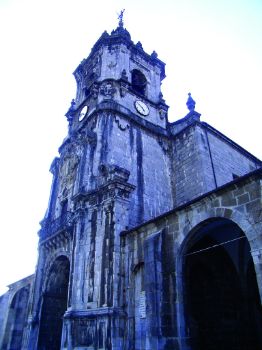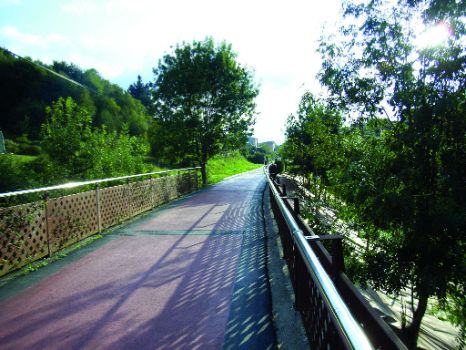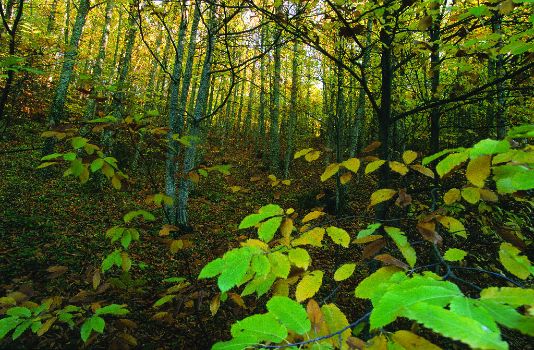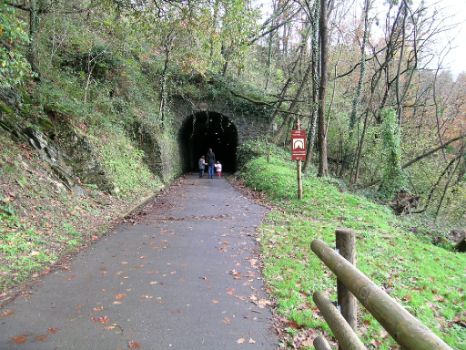Net of Natural
Trails

Plazaola Nature Trail. Andoain - Leitzaran Section
Description
Charming rural trekking
Andoain is a peaceful town in the Basque Country, located half-way between Donostia-San Sebastián and Tolosa. In its beginnings, it was fought over by both municipalities, before becoming a town in the 17th century. Within its environment, it currently combines country houses and small industries and is an excellent operational base for trekking enthusiasts.
The path begins behind an industrial warehouse, to the left of the entrance to this peaceful town. The Trail, which runs along the route of an old railway track, forms part of El Camino de Santiago or St. James’ Way. After crossing a tunnel, it continues in a south-westerly direction entering the town little by little. On its way, it passes, on its left, meadows and farming areas and, on its right, a children’s park next to some buildings.
The Trail continues upwards across the town’s streets, passing by the top part of the church, next to the Tourist Information Bureau. When it reaches this point, it runs along the old railroad track again, between stone walls until, once again, it reaches a street which you follow for some 300 m and then turn left along a red cobblestoned lane which leaves the town.
After passing by some benches and a fountain, the Trail reaches a wooded area of oaks (Quercus sp.), maples (Acer sp.), chestnuts (Castanea sativa), etc. and then enters a tunnel which is almost 100 m long, well-lit and in good condition, taking the trekker to an area outside the influence of the town centre.
The Trail continues by advancing up the hillside between forests and pasturelands as far as a fork where you can either enter the recreational area of Olazar Park, behind some steps towards the bottom of the valley, or carry on to Leitzaran (Leizarán). On the way to this town, the route crosses a high viaduct from where you can see magnificent views of the River Ubaran, tributary of River Leitzaran.
After crossing it, a few metres on, you will have to pass over the Otieta tunnel, which is 280 m long and is the longest on the route. After exiting the tunnel and continuing for a short stretch, the Nature Trail ends by connecting to the pathway network of the Natural Space of the Valley of Leitzaran, which was listed as a Protected Biotope in 1995.
Managing Entities
Puntos de interés
Culture
Infrastructure
- Túnel de Arantzazunea
- Túnel
- Túnel Antzizar
- Puente de Unanibia
- Viaducto de Auzokalte
- Estación de Andoain
- Túnel Otieta
Municipality
Vegetation
Profile

(Calculated according to the MIDE criteria for an average excursionist with a light load)
Highlights
Further information
The Parish Church of San Martín de Tours
This Baroque church, which was built between 1759 and 1770, has a Latin cross floor plan with a three-aisle nave. The ribbed vaults and the arch ribs that form it rest on classical pillars. The most outstanding part of the temple is its monumental tower, which is located in the central section of the façade.
Plazaola railway line
This railway line, running on narrow railway tracks and having steam traction, was a mine train that used to take iron from the mines of Plazaola to Andoain, Guipuzkoa, in the early 20th century. In 1914, the Plazaola became a passenger train covering the 84 km between Pamplona and San Sebastián. It ran for 40 years and, during this time, it became a commercial and communication route between Navarra and Guipuzkoa, as well as a cultural exchange centre. Although it did not stand out due to its economic importance, it was very popular along its route, being commonly known as “the Plazaola”, “Plazaola train”, “Plazaola railway” and also as “txiki train” (although this nickname was also used for other trains, such as the one going from Irún to Elizondo).This train had regular service in the following stations: Pamplona (city), Pamplona (junction), Aizoain, Sarasa, Gulina (stopping place), Irurtzun, Latasa, Lekunberri, Uitzi, Leitza, Areso (stopping place), Plazaola, Ameraun (stopping place), Olloki, Andoain, Lasarte (Bilbao – Basque Railways junction), Añorga y Donostia (Amara). There were two other stopping places, Bizkotx and Beiñes, which did not appear among the train regular stops.
The passenger transport line was closed due to the floods occurred in October 1953, which destroyed several bridges and railway track sections, making the railway useless, in addition to the tough competition with the coach lines. However, it continued providing some goods transport services in the Leitzaran of Guipuzkoa. In 1958, the railway was definitively closed, the track was lifted and the facilities dismantled.
Today, a great part of the old railway track has been recovered as a route for leisure activities, making up the Plazaola Nature Trail, which runs among meadows, forests, both native (oaks, beeches, alder trees...) and reforestation pines. It also crosses the Larraun valleys and the Leitzaran river (which has been declared a Protected Biotope).






